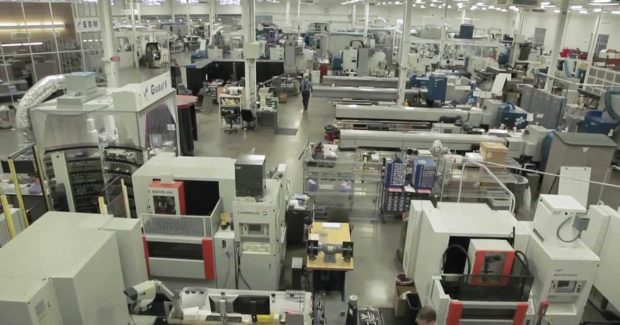Synching Your Shop Floor: ERP and MES Integration for Better Planning, Insight and Execution
The integration of ERP and MES starts with a cultural change within a manufacturer that embraces Big Data, mobile and Internet of Things technologies. They must add new data and process integration capabilities to their operations and improve flow/use-of-data from the top floor to shop floor. By doing this now, they will avoid becoming overwhelmed and outflanked by their competition.
Posted: December 29, 2016
Operational visibility on the shop floor has traditionally been enabled by manufacturing execution systems (MES), supporting real-time process control scenarios and quality initiatives. Conversely, enterprise resource planning (ERP) has been in use in manufacturing operations, primarily supporting order execution, optimized scheduling and inventory management, quality checks, traceability and planning. On its own, each system can provide a host of benefits, but fabricated metal manufacturers with an eye for improved performance and competitive advantage are now integrating MES and ERP to gain better alignment in activities from top floor to shop floor.
GETTING DOWN TO BUSINESS: SYSTEMS BENEFITS
The manufacturing environment of today is pushing companies to implement next-generation ERP systems that can support collaboration, offer flexibility to adapt to unique requirements, improve customer responsiveness and drive growth. The days of ERP as a tool to simply automate business processes are gone; now manufacturers rely on ERP to support growth by always being ready to take advantage of new opportunities while mitigating risks.
MES delivers consistent, accurate, and visible machine and production execution metrics that operations management can use to identify underperforming and high-performance processes and machines and then optimize asset utilization accordingly, to eliminate bottlenecks. Performance efficiencies gained from MES can open up the possibility of increasing output and profitability, all from existing production assets. Additionally, creating an automated “digital thread” improves responsiveness, lowers costs, and improves the accuracy of production and quality performance information that can be used for deep insight into strengthening the operations and execution of production processes.
MOVING FROM DISPARATE SYSTEMS TO A UNIFIED PLATFORM
A key challenge facing manufacturers is the need to effectively align planning, scheduling and quality initiatives via data from ERP and MES into one centralized platform. With this integration, manufacturers can benefit via real-time machine and quality data that can be imported into an ERP system to better plan their schedules and resources to meet customer demand, optimize service levels, and avoid these situations:
- No insight into shop floor operations. Having no visibility to the shop floor can slow decision-making, resulting in delays and reduced customer satisfaction. Understanding current capacity and conditions on the shop floor helps manufacturers to better plan to meet customer demand.
- MES and ERP not on the same page. ERP and MES systems are typically purchased from different vendors, which often means manually entering data from one system into another to enable both to communicate with each other, or the need for bulk imports of data that don’t match each system’s unique structures. Having a unified platform where ERP and MES “speak” the same language can eliminate the need for these time-consuming manual interventions.
- Increasing inventory costs. Real-time alerts and notifications regarding issues on the shop floor can set off alarm bells, enabling immediate action to resolve problems. However, without real-time shop floor data access, manufacturers run the risk of higher amounts of scrap and inventory that negatively impact their bottom line.
The integration of ERP and MES enables manufacturers to achieve a holistic view of their business processes and core production, and better utilize shop floor data and labor resources – crucial to improving operational efficiency and maximizing profitable manufacturing outcomes. This delivers more accurate data from the shop floor to the top floor, enabling manufacturers to adjust schedules and processes based on production capacity and machine availability.
Real-time reconciliation of information between ERP and MES ensures data integrity for supporting accurate scheduling, planning, monitoring, resourcing and costing. This integration spans structural data, job scheduling and production reporting, effectively pulling data into a seamless bi-directional information environment. Users benefit significantly from improvements in promise-to-order, labor and equipment utilization, and business intelligence when there is tight integration between ERP and MES and real-time feedback. In addition, a real-time digitized closed loop between the business systems and the plant floor provides an accurate up-to-the-minute view of machine and production availability for improving operational effectiveness and responsiveness.
WHAT TO KEEP IN MIND WHEN SELECTING SYSTEMS
Before purchasing and evaluating MES and ERP systems, manufacturers need to assess from the beginning what will need to be accomplished on the shop floor with each system since they often are implemented on separate timelines. It is important that a company’s chief financial officer and chief information officer come together to understand the opportunity around the ERP/MES integration. The integration of ERP and MES starts with a cultural change within a manufacturer. As manufacturers embrace Big Data, mobile and Internet of Things (IoT) technologies, new data and process integration capabilities must be added to the organization’s operations. Manufacturers need to strive to improve flow/use-of-data throughout the organization – from the top floor to shop floor. Organizations doing this now will avoid becoming overwhelmed and outflanked by their competition.
The integration of ERP and MES leads to better planning that improves a company’s overall operations. This also enables the executive team to lead more effectively and better understand their profit/loss to make the right decisions to grow the organization. Both of these systems, together, offer manufacturers real advantages that should not be overlooked as they seek strategies for growth in the new year.















